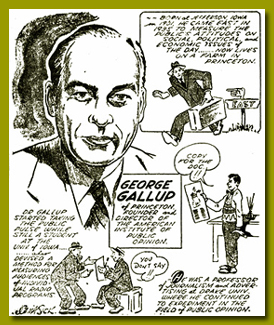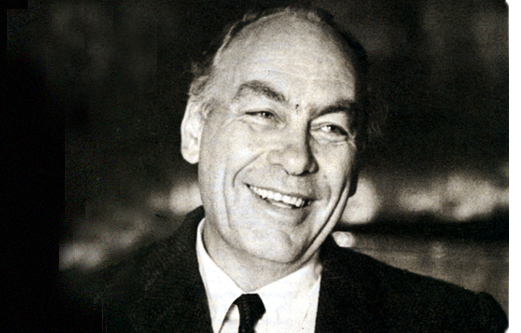 Gallup's career began with his upbringing
in Jefferson. He was an avid student and
toiled at many jobs. His education continued
at the University of Iowa in journalism. He
began to measure reader interest in
magazines and newspaper features while a
student. His Ph.D. thesis in psychology was
titled "An Objective Method for Determining
Reader Interest in the Content of a
Newspaper," and used scientifically selected
samples. Gallup had begun his lifelong
passion of measuring public attitudes on
political, social and economic issues of the
day.
Gallup's career began with his upbringing
in Jefferson. He was an avid student and
toiled at many jobs. His education continued
at the University of Iowa in journalism. He
began to measure reader interest in
magazines and newspaper features while a
student. His Ph.D. thesis in psychology was
titled "An Objective Method for Determining
Reader Interest in the Content of a
Newspaper," and used scientifically selected
samples. Gallup had begun his lifelong
passion of measuring public attitudes on
political, social and economic issues of the
day.
Having gone on to teach at Iowa, Drake
and Northwestern before he was 31, he
was invited by Ray Rubicam to join Young and
Rubicam, then the largest advertising agency
as head of the market and copy research
departments in 1932. At Y&R he carried on
his research with print media, meanwhile
establishing the first nationwide radio
audience measurement by the coincidental
method, which he had previously devised.
Later he developed the Impact method - the
widely used copy testing procedure to
measure advertising effectiveness.
In that same year, he began his research in
the field of public opinion and election
forecasting urged on, in part, by his
mother-in-law, Ola Babcock Miller, having
been placed on the Democratic ticket in
Iowa, in honor of her husband's efforts for
the party. It seemed unlikely she would be
elected, however, Mrs. Miller was elected in
1932 as Iowa's first female Secretary of
State -- a result George Gallup predicted in
what has been called the first scientific
political survey ever conducted.
As a result of measuring the electorate in Iowa, and drawing on his journalism experience and work in the research business, Gallup began to develop the idea for a national weekly poll of public opinion. Gallup founded the American Institute of Public Opinion in Princeton, New Jersey, and on the 20th of October, 1935, the first release was printed. Soon thereafter he established the British Institute of Public Opinion. At about this same time, he undertook a complete research program for Hollywood movie studies - research that measured the appeal of story ideas, box-office appeal of stars, publicity penetration, preview reaction - and ending with a forecast of box office returns. In this field he worked with David Selznick, Walt Disney, Sam Goldwyn and others. One of the most researched pictures in movie history was "Best Years of Our Lives" - a picture which won 10 Oscars. In 1948, he co-founded with Claude Robinson, the founder of Opinion Research Corporation (ORC), the advertising and marketing research firm of Gallup & Robinson, Inc., now The G&R Cooperative, LLC.
At about this time, Gallup, along with the other two leading polling companies - Roper and Crossley - miscalled the Truman election. Lulled into thinking that few votes would change after the start of the presidential campaign, interviewing had been stopped several weeks before the election, predicting a win for Republican Thomas E. Dewey, and missing a swing of third-party voters back to Harry S. Truman's camp in the final days of the campaign. Gallup write, "If the 1936 election performance of scientific polls [correctly picking the Roosevelt victory against conventional wisdom] gave the fledgling industry considerable credibility with the U.S. public, their performance in the 1948 election threatened to undo everything... As long as public opinion is important in this country, and until someone finds a better way of appraising it -- I intend to go right ahead with the task of reporting the opinions of the people on issues vital to their welfare."
In addition to his determination, what separated Gallup from others was his strong social conscious. He believed that the solutions to many of societies problems would be found in understanding the thoughts and feelings of the individual. He always insisted that the next great development in medicine would come from a thorough exploration of environmental factors associated with illness - food and work habits, medical history, ancestry, psychological attitudes, and the like. To prove his point he conducted a variety of landmark studies ranging across the human condition, from infantile paralysis in the pre-Salk era, to factors related to old age, to psychological well being, to the quality of life in all areas of the world.
Serving as Chairman of the Board of the Gallup Organization and Chairman Emeritus of Gallup & Robinson, Dr. Gallup remained active in business until his death in July of 1984.
Today, Gallup's ideas have become the foundation for how society's institutions connect with and make decisions about people's thoughts, feelings and needs. From the representatives we elect, to the media we watch, to the products we buy, to how we understand ourselves compared to others, Gallup's ideas, methods and vision have gained worldwide application and acceptance.


